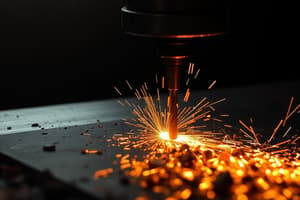Podcast
Questions and Answers
What is the cutting speed, v, usually expressed in?
What is the cutting speed, v, usually expressed in?
- mm/min
- mm/rev
- m/min (correct)
- m/s
In turning, what is the feed defined as?
In turning, what is the feed defined as?
- Tool diameter advancement
- Distance tool advances in one workpiece revolution (correct)
- Saw blade speed
- Workpiece rotation rate
How is feed rate, f, usually expressed?
How is feed rate, f, usually expressed?
- m/min
- mm/rev (correct)
- rpm
- m/rev
What is depth of cut in machining?
What is depth of cut in machining?
How is cutting speed, V, calculated in turning?
How is cutting speed, V, calculated in turning?
What does rotational speed, N, represent in machining?
What does rotational speed, N, represent in machining?
What is the formula for calculating rotational speed, N?
What is the formula for calculating rotational speed, N?
Which parameter refers to the movement of the tool cutting edge in millimeters per revolution of the workpiece?
Which parameter refers to the movement of the tool cutting edge in millimeters per revolution of the workpiece?
What does depth of cut measure in relation to the workpiece surface?
What does depth of cut measure in relation to the workpiece surface?
Why is it important for the cutting fluid to have good cooling ability?
Why is it important for the cutting fluid to have good cooling ability?
What is the main purpose of good lubricity in cutting fluids?
What is the main purpose of good lubricity in cutting fluids?
Why is low viscosity important for cutting fluids?
Why is low viscosity important for cutting fluids?
What does high clearness in cutting fluids help achieve?
What does high clearness in cutting fluids help achieve?
Why should the cutting fluid have good transportability?
Why should the cutting fluid have good transportability?
What role does the cutting fluid play in reducing friction forces at bearing areas?
What role does the cutting fluid play in reducing friction forces at bearing areas?
How does the cutting fluid contribute to preventing seizure at the cutting and contact areas?
How does the cutting fluid contribute to preventing seizure at the cutting and contact areas?
What effect can low viscosity of cutting fluid have on machining efficiency?
What effect can low viscosity of cutting fluid have on machining efficiency?
Why is high clearness important in a cutting fluid?
Why is high clearness important in a cutting fluid?
Why must a cutting fluid have good transportability?
Why must a cutting fluid have good transportability?
Flashcards are hidden until you start studying



